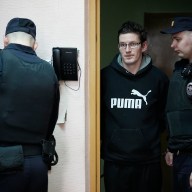OTTAWA – The 1,000 Canadian soldiers departing for Haiti over the next week are facing an increasingly volatile security situation as anger and desperation grow in the wake of last Tuesday’s killer earthquake.
Foreign Affairs Minister Lawrence Cannon says security has been fingered as one of the key challenges facing relief and reconstruction efforts as aid slowly ramps up and the death toll continues to mount.
“Although the concern over an increase in civilian violence is shared by several countries involved, it will be resolved by our capacity to deliver aid and our capacity to stabilize Haiti,” Cannon said Monday.
Some of the infantry coming out of the Royal 22nd Regiment’s base at Valcartier, Que., will be tasked with ensuring the “humanitarian corridor” remains open, he said.
The deteriorating security situation – looting, attacks and other violence – was identified as a key challenge during a teleconference Sunday with the Friends of Haiti, which includes 16 countries.
Cannon said the foreign ministers from North, Central and South America, along with UN officials and Haitian Prime Minister Jean-Max Bellerive, said police efforts must be supplemented until the national force can be re-established.
“We all called for a better co-ordination,” Cannon said Monday.
“Obviously there’s a problem in getting this (aid) through.”
Eleven Canadians had been confirmed dead by early Monday – an increase of three from Sunday. No names had been released yet.
Another 859 were still missing, Cannon said. Ten flights had evacuated 947 Canadians from the quake zone, with another scheduled to land early Monday in Montreal.
But he said hopes of finding people safe and sound were waning now that the catastrophe is in its sixth day, and Canada’s efforts are increasingly focused on evacuation and provision of basic needs.
“The situation remains fragile and we still face . . . a large number of challenges,” he said.
Canada is fully engaged in the relief effort and will remain so as reconstruction of the ravaged Caribbean island country gets underway, Cannon added.
Two Canadian ships loaded with army personnel, equipment and supplies were to dock soon, although a final decision about where to land had not yet been made, said Defence Minister Peter MacKay.
Canada is looking closely at using Jacmel as a port of entry for at least one of the ships. The coastal town is about 50 kilometres from Port-au-Prince and was also heavily damaged in the Jan. 12 quake.
MacKay said its airstrip, after some repairs, could handle Canada’s C130 Hercules planes, but not the enormous C17s. The port was damaged, but Canada’s ships could anchor nearby and ferry goods and people to shore in inflatable boats or aboard Sea King helicopters.
“It is becoming increasingly evident the scale and scope of the devastation wrought by the earthquake is enormous and presents a substantial challenge,” said MacKay.
“But the momentum and the movement and the commitment shown so far illustrates that we’re making a positive difference.”
Force protection and security remain fundamental elements of the relief effort, and Canadian troops “want to ensure that we’re able, in an orderly way, to deliver aid, water and provisions of life.”
A reliable death toll may be weeks away, but the Pan American Health Organization estimates 50,000 to 100,000 died in the 7.0-magnitude quake. Haitian officials believe the number is higher.
People were still dying on the streets, pregnant women were giving birth and the injured were showing up in wheelbarrows and on people’s backs at hurriedly erected field hospitals.
Water began to reach more people around the capital and, while fights broke out elsewhere, people formed lines to get supplies handed out by soldiers at a golf course.
Still, with a blocked city port and relief groups claiming the U.S.-run airport is being poorly managed, food and medicine are scarce. Anger was mounting hourly over the slow pace of the assistance.
“White guys, get the hell out!” some survivors shouted in the city’s Bel-Air slum, apparently frustrated at the sight of foreigners who were not delivering help.
Crowds were reportedly attacking UN vehicles in the slums outside the city, accusing the international community of doing too little to distribute food. There were also reports of looting, including at least one case in which looters made off with a coffin from a funeral home.
The Vandoos will complement 500 soldiers aboard the two navy ships, as well as the 200-plus members of Canada’s Disaster Assistance Response Team, who are still deploying.
Two Canadian Forces Hercules and two C-17 heavy-lift aircraft, along with a helicopter contingent, are also operating in Haiti, delivering relief supplies and evacuating Canadians. Officials estimate more than 200 Canadian Forces personnel are already on the ground.
Brig Gen. Guy Laroche is commanding the Canadian contingent, which will ultimately include about 2,000 Forces personnel, hundreds of vehicles and seven helicopters.
The Vandoos are scheduled to deploy to Afghanistan next December, and many of the troops preparing to leave for Haiti are volunteers who’ve just returned from the war. They require special waivers due to regulations governing their time between deployments.
The new contingent of soldiers will bring along engineering units, as well as headquarters and support elements and 60 additional vehicles, MacKay said Sunday. The contingent includes almost enough medical staff and supplies to man a field hospital.
Cannon spent an hour on the phone Sunday with key players in the efforts to get Haiti back on its feet. The Group of Friends of Haiti began talks on long-term reconstruction efforts and agreed to meet in Montreal on Jan. 25.
Next week’s meeting will take stock of the needs of Haiti and set up a larger, top-level aid meeting later on, Cannon said.
















